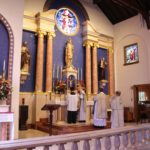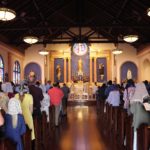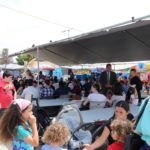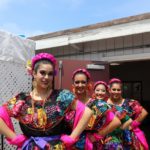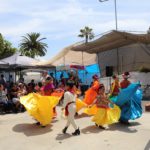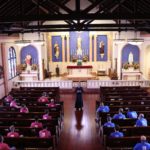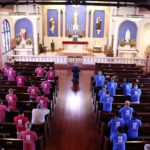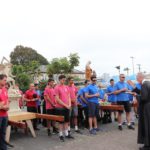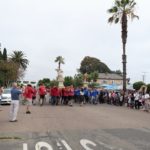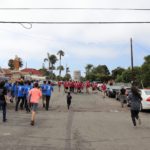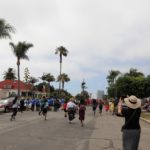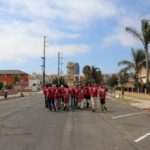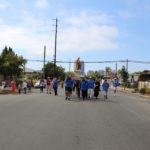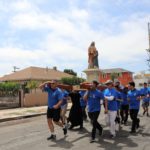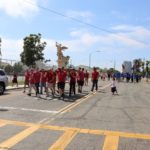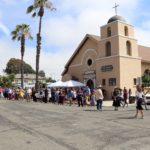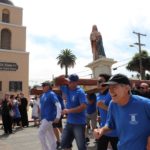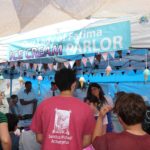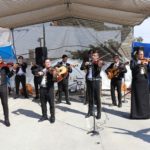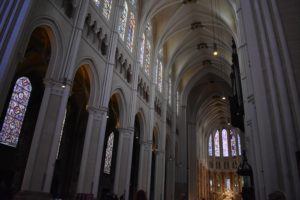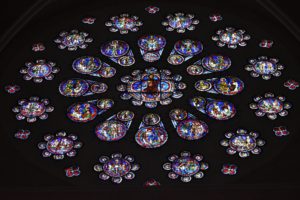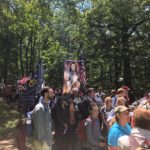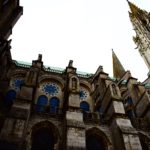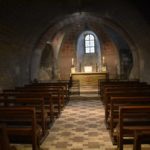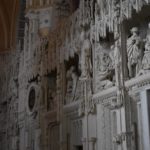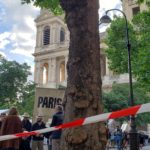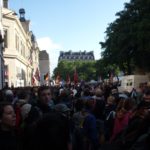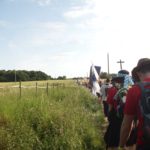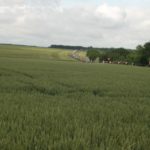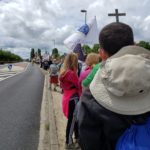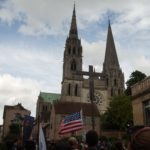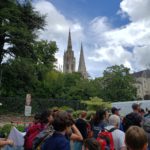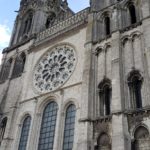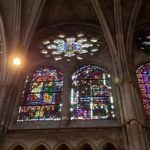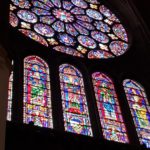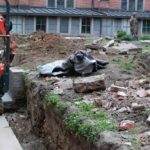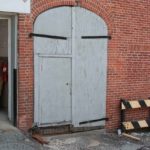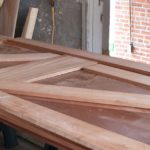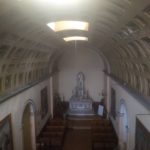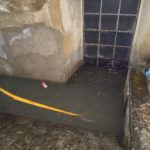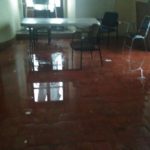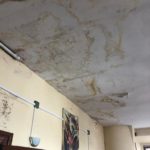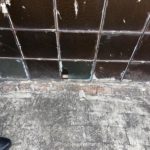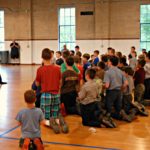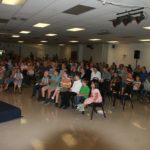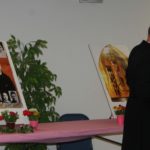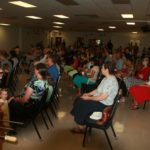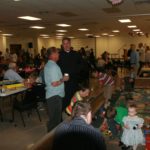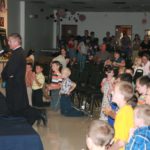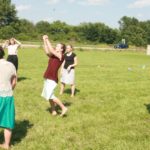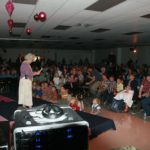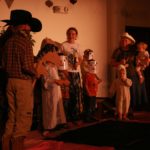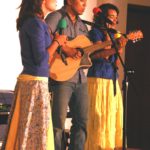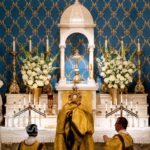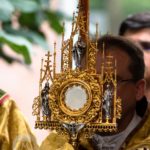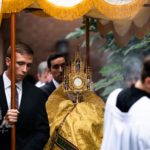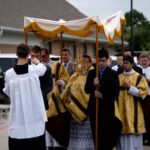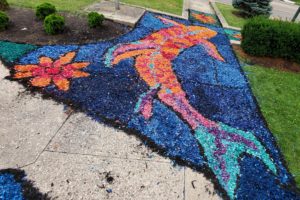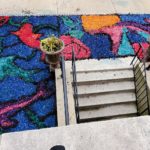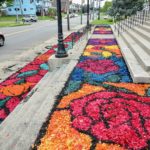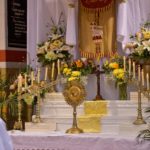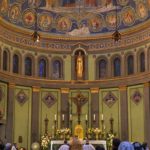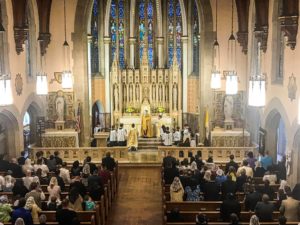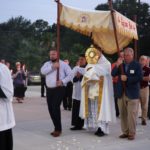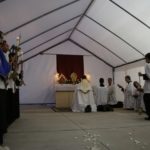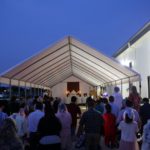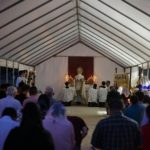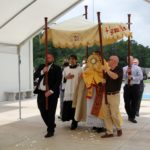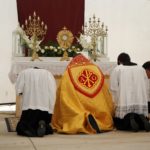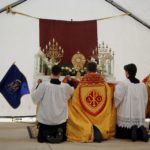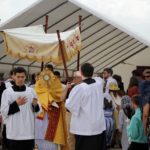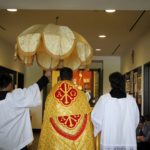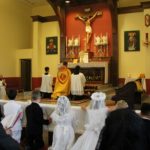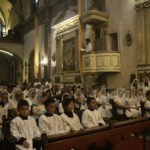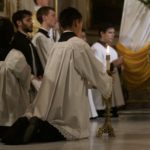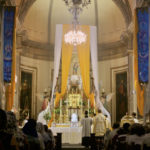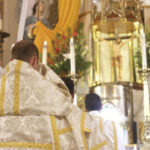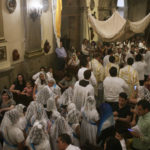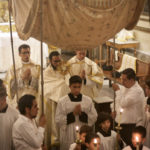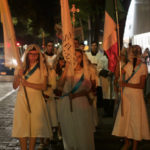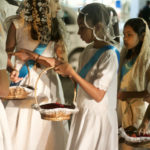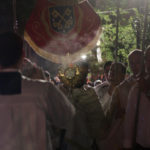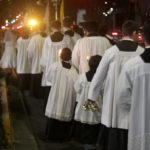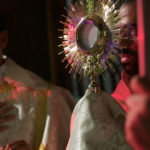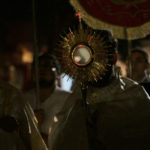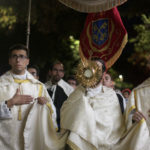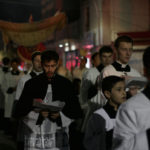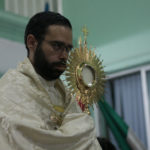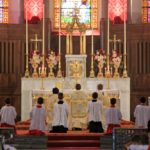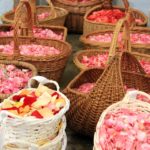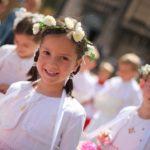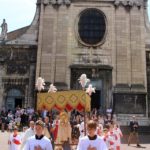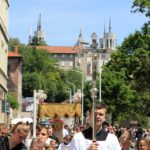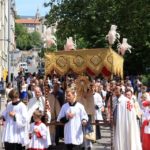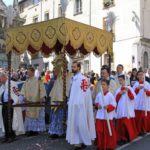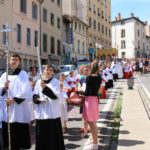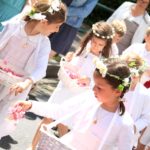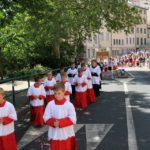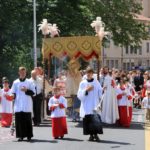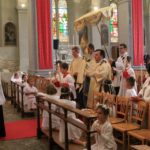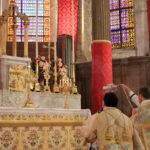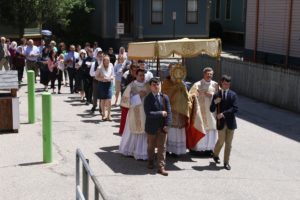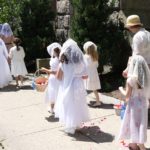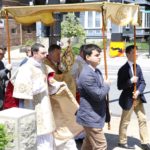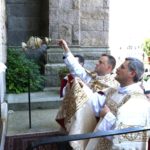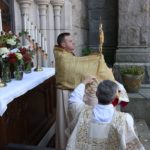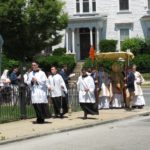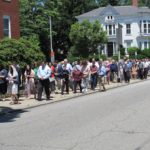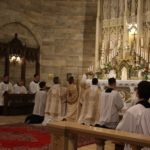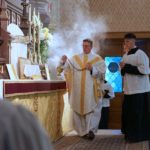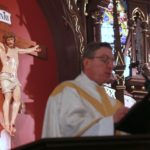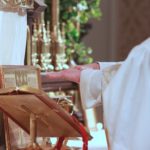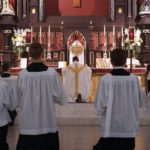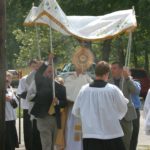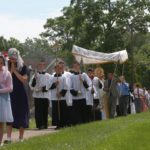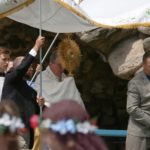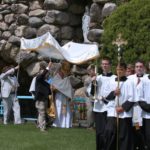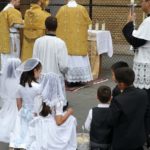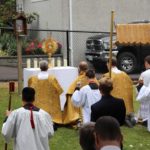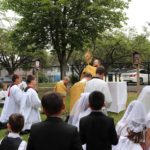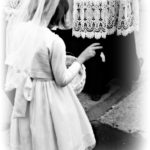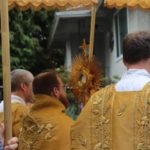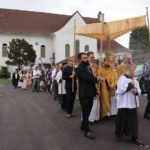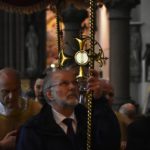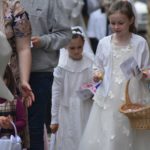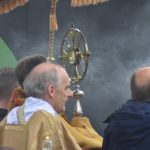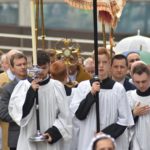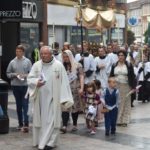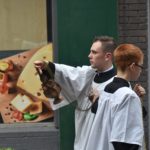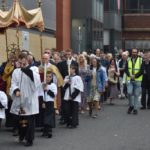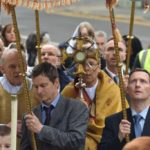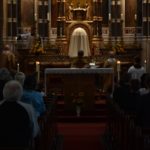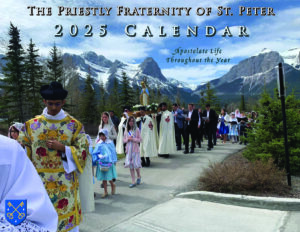Saints Alive
You just started running. You couldn’t help it.
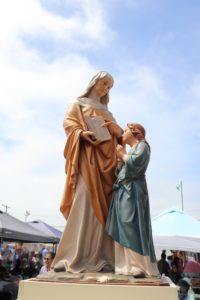
The annual Running of the Saints held by St. Anne Parish, our apostolate in San Diego, California, is a strange and wonderful event. An Italian tradition particular to the town of Gubbio, it was imported to the United States by the hands of immigrants to the humble town of Jessup, Pennsylvania, just down the road from our headquarters in South Abington. Gubbio holds La Festa dei Ceri on the eve of the May 16th feast of their patron, St. Ubaldo, the event involving a “race” through the streets of the town among St. Ubaldo, St. George and St. Anthony, whose statues are borne on the shoulders of teams of men wearing the colors of their saint (yellow, blue or black, respectively). Jessup holds its event on Memorial Day weekend, and if you drive through the town around this time, you will see the colors of the saints displayed outside houses as families show their support for their saint. Fr. Carl Gismondi, former pastor of St. Anne, brought the tradition to his San Diego parish, and they adapted it to their own patroness, holding it every year on a Sunday near her July 26th feast day.
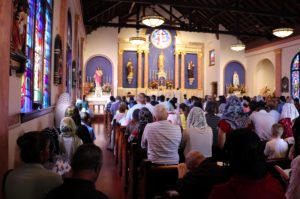
This year, the Sunday in question was July 28th. The Running is not the only event in honor of St. Anne that day; it is but the crown on a day of celebration constituting St. Anne’s “Fiesta”. The festivities began at 9am with a Solemn High Mass, celebrated as the External Solemnity of St. Anne. Attendance was astounding. The pews were filled and attendees amassed in the back and in the side aisles. To accommodate the anticipated overflow, seating was set up ahead of time outside the parish doors under a shade-producing covering.
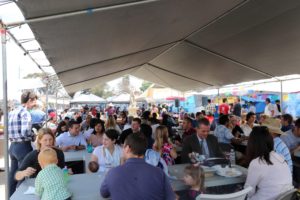 After Mass, the fiesta began. The work of setting up for this grand event, which was held in the relatively small courtyard and parking lot adjacent to the church, was not a burden shouldered by a few: the parish had turned out in force on Saturday to assist one another with the myriad tasks involved. Space was limited but utilized to perfection. Smaller tents were set up along the outside of the parking lot to accommodate the various food and drink booths, and large tents provided cover for long tables and chairs. A misting system was even installed in the large tents, a real blessing on a sunny summer day in southern California!
After Mass, the fiesta began. The work of setting up for this grand event, which was held in the relatively small courtyard and parking lot adjacent to the church, was not a burden shouldered by a few: the parish had turned out in force on Saturday to assist one another with the myriad tasks involved. Space was limited but utilized to perfection. Smaller tents were set up along the outside of the parking lot to accommodate the various food and drink booths, and large tents provided cover for long tables and chairs. A misting system was even installed in the large tents, a real blessing on a sunny summer day in southern California!
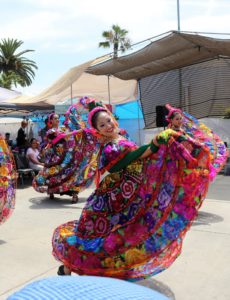
Breakfast was served after Mass, and the pro-life group provided iced coffee and smoothies. Throughout the day the food offerings included “A Taste of Manila”, a perennial favorite serving Filipino fare, Our Lady of Guadalupe Mexican Food, St. Juan Diego Tacos, St. John Bosco Hamburgers and Our Lady of Fatima Ice Cream Parlor. Attendees could try their luck at “Duck Range” and other games or at the table full of raffle prizes. A popular feature among the young ones was Jacob’s Ladder, a horizontal ladder that swiveled and swung and challenged the kids not to fall to the soft, bouncy surface below. Traditional Mexican dancers in colorful attire performed early in the day, and later on a mariachi band with guitars, violins and talented voices filled the air with the sounds of the country that lies only 15 miles south of San Diego.

But the lively fiesta was only the outward sign of an inward reality. Congregations are not happy unless they are first holy, and the joy on display that day was hardly a product of palm trees and beaches. Theirs is a joy that comes from within, fueled by the Sacrifice so well attended that morning and that is normally celebrated five times on Sunday and twice every other day of the week. Additional spiritual sustenance comes from Exposition of the Blessed Sacrament Monday through Saturday (Exposition is Solemn on Friday and Saturday) and Vespers on Sunday. Various parish groups round out the life of the parish, including a particularly vibrant young adult group that sees 45 – 50 attendees at its weekly events.
Larissa Lopez, a young adult who recently began attending St. Anne’s, told us a bit about what draws her to this parish.
“The community is awesome,” she explained. “I feel alive here.”
Andrew Daniels, another young St. Anne attendee who participated in the Running on the St. Michael team, echoed the sentiment. “I love everything about this parish,” he said.
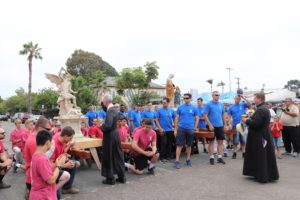
Round about 3pm, it was time for the much-anticipated Running. Men dressed in t-shirts colored red for St. Michael or blue for St. Anne gathered in the church for a short talk by pastor Fr. John Lyons on the meaning of the event and a time of pre-Running prayer. Once outside, the runners gathered about the statues that stood mounted on wooden platforms and Fr. Lyons blessed the saintly cargo, sprinkling it with holy water. The participants hoisted their saints on their shoulders and they were off, traveling up Irving Avenue towards downtown San Diego, the gleaming buildings of the city looking down on the unusual goings-on from a couple miles away. Eight or ten runners would carry the platform at one time, with their teammates switching in and out as 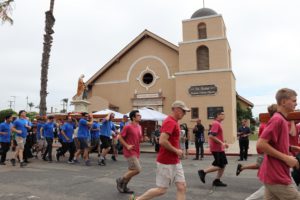 necessary. Vigorous shouts of “St. Anne, pray for us!” rose into the late afternoon air as they ran, the voices issuing what seemed like not only a plea to the saints but also a challenge to competitor and spectator alike. You heard it and your blood and your feet began to move in a way that maybe you didn’t expect, the sweat and pain of a mile run in the heat of the afternoon down unforgiving asphalt evaporating in the inspiration you felt at the sight and sound of such great faith in motion.
necessary. Vigorous shouts of “St. Anne, pray for us!” rose into the late afternoon air as they ran, the voices issuing what seemed like not only a plea to the saints but also a challenge to competitor and spectator alike. You heard it and your blood and your feet began to move in a way that maybe you didn’t expect, the sweat and pain of a mile run in the heat of the afternoon down unforgiving asphalt evaporating in the inspiration you felt at the sight and sound of such great faith in motion.
 And that certainly is the answer to any question as to the “point” of such proceedings. Not only is the Running a display of our Faith that is a visible and audible witness to the world, it is also a rousing call to action, a reminder that our God and our heavenly patrons are indeed truly alive – alive, in action and taking our sanctification much more seriously than we do ourselves on a daily basis. They are calling to us to rise from sleep and from the spiritual lethargy that tempts us all at times, to move our hearts, minds and feet towards the heavenly goal where they are already awaiting us and cheering us on to victory.
And that certainly is the answer to any question as to the “point” of such proceedings. Not only is the Running a display of our Faith that is a visible and audible witness to the world, it is also a rousing call to action, a reminder that our God and our heavenly patrons are indeed truly alive – alive, in action and taking our sanctification much more seriously than we do ourselves on a daily basis. They are calling to us to rise from sleep and from the spiritual lethargy that tempts us all at times, to move our hearts, minds and feet towards the heavenly goal where they are already awaiting us and cheering us on to victory.
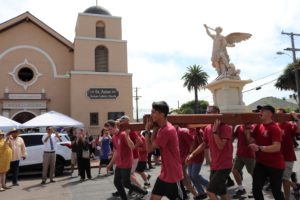
Who won, you ask? No one, officially. The Running is, in fact, not a race, despite our calling it so. In the original Gubbio version, St. Ubaldo always wins, and from what we gather, St. Anne normally finishes first in San Diego. But in a result that stunned the Running world, St. Michael pulled off an upset victory over the defending champion. Maybe the two of them were letting us know that we should run so as to win. +
August 13, 2019
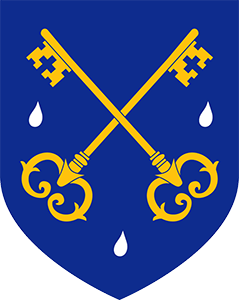
Support the Annual Appeal for Seminarian Formation!
The Annual Appeal is our most important fundraiser of the year for forming traditional priests.
August 7, 2019

Reflections from Chartres
On June 8th, 2019, the Vigil of Pentecost, thousands of Catholics set out on foot from Paris, bound for the Cathedral of Chartres that they would reach two days later as part of the famous pilgrimage that bears the destination city’s name. Many of our priests, seminarians and parishioners were with them, and two young parishioners, one from St. Joan of Arc in Coeur d’Alene and one from North American Martyrs in Seattle, shared with us their memories of the journey.
by Zoe Brown, FSSP Coeur d’Alene
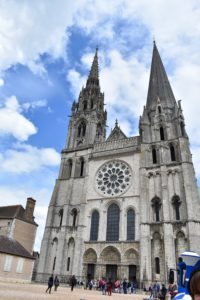
It began nearly a thousand years ago, this throng of pilgrims travelling to the Cathedral of Notre-Dame de Chartres in order to see the precious relic it houses, the Veil of Our Lady. As an organized event, however, the pilgrimage began in 1989 and has continued every year since.
It began for us at dawn outside the second largest church in Paris, the magnificent Saint-Sulpice. A crowd of 14,000 faithful Catholics from all over the world waited outside, flying the colorful banners of their separate chapters, all come together to begin this unbelievable journey that has become legend—the Chartres Pilgrimage, a 70-mile walk over 3 days around Pentecost, from Paris to Chartres. Thousands of pilgrims gather with one intent, to offer prayer and penance and to honor Our Lady.
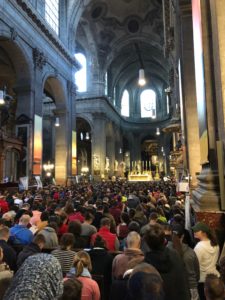
A beautiful Solemn High Mass inside the church was the starting point of the journey—our chapter (St. Joan of Arc) was so fortunate as to be inside for Mass, whereas a huge crowd spilled out all around the church. Then, soon enough, we were unfurling our flags, and setting out on the first grueling march.
On the first day of the trip, we wound our way through the sophisticated streets of old city Paris, all cream stone and delicate iron filigree. We walked to the outskirts of the city and beyond, into the picturesque French countryside composed of tiny stone cottages and vast farm fields of waving grain. Laughing, singing, talking, in friendly fellowship and good faith, praying rosaries and saying the Stations of the Cross, we walked 28 miles before reaching camp. It was a long, hard day, painful but worth every moment.
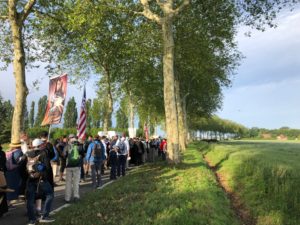
Exhausted and hurting, but ready for anything, we woke at 5:00 the next morning and enjoyed a cup of coffee before setting out once more, again winding through seemingly eternal fields bordered by woods. Often enough an endless line of vivid banners stretched to the edge of both horizons. Our thousands of pilgrims marched down the narrow, winding main street of tiny hamlets, the townspeople watching with delight. By the end of the day we were utterly worn out after walking some 26 miles, but we could see the tiny spires of Chartres in the distance, so close.
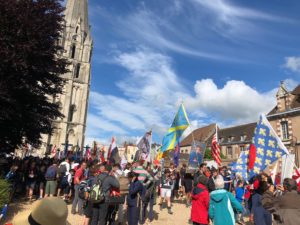
With 15 more miles to go, we walked the next day with the end in sight. After a long climb up the town’s hill to reach the breathtaking cathedral at its crown, we were there. We had made it. The pilgrims crowded into the cathedral’s courtyard and beyond, a throng of relief and delight, and Solemn High Mass began.
Chartres is stunningly beautiful, restored in shades of white and cream, lit by gorgeous stained glass. Our chapter heard Mass in the crypt of the cathedral, and we had an entire day to explore.

We all will cherish our memories and experiences of the Chartres Pilgrimage—even the hard times, the times that hurt, but especially the infinite moments that made the trip beautiful. We are traditional Catholics in a modern world that tries to tell us that our Faith is dead, irrelevant, worthless. It’s wrong. There is no stronger sense of community and solidarity than in this vast crowd of Catholics, where the strength of faith is tangible and feels so alive, so vibrant, both ancient and new. This pilgrimage is a reminder once again of the life, beauty and eternity of Catholicism. +
The Chartres pilgrimage is something special. It is by no means easy. It challenged me in a way I had never been challenged before, but it has hands down been the most rewarding thing I have done in my life.
– Kerrie Lawson, FSSP Seattle
Photos by Zoe Brown
Additional photos by Kerrie Lawson
August 2, 2019

Happy Feast of St. Peter in Chains!
Today is the old feast of St. Peter in Chains, a day that commemorates St. Peter’s miraculous escape from prison by the hand of an angel. He had been incarcerated by Herod Agrippa, who had already killed St. James the Greater and intended to bring St. Peter before the people also after Easter. But, as the Acts of the Apostles tells us, “prayer was made without ceasing by the church unto God for him”, and he was delivered by an angel who awoke him in the night, led him past the guards and out of prison.
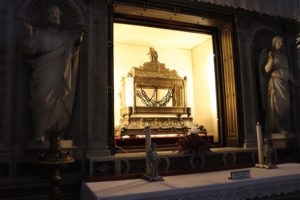
Though no longer included in the general liturgical calendar, the feast of St. Peter in Chains is nonetheless an important day for the Priestly Fraternity of St. Peter. The pilgrims who joined the Fraternity on our 30th Anniversary Pilgrimage to Rome last October visited the Basilica of St. Peter in Chains, where they were able to venerate the chains of St. Peter.
Also commemorated today are the seven Maccabees, the holy brothers who were tortured and killed before the eyes of their mother in the 2nd century before Christ for refusing to abandon the Jewish faith. Please pray today for the priests of our Fraternity, that, through the intercession of our patron St. Peter and the holy Maccabees, we may ever possess the same fortitude and love for the Faith that enabled them to endure all things for its sake. +
And Peter coming to himself, said: Now I know in very deed, that the Lord hath sent his angel, and hath delivered me out of the hand of Herod, and from all the expectation of the people of the Jews.
– from the Epistle for the feast of St. Peter in Chains
August 1, 2019

FSSP Baltimore’s Novena for Lapsed Catholics Begins 8/2

Most of us have relatives or friends who have fallen away from the Faith, and many constant souls have been praying faithfully for a long time for the return of their loved ones. Every year, FSSP Baltimore offers a wonderful opportunity to pray in a special way for the lost sheep that we know. Beginning on the August 2nd feast of its patron, the National Shrine of St. Alphonsus Liguori holds a week-long novena of Masses for fallen-away Catholics. St. Alphonsus was a devoted confessor and had a great love and care for penitents, and hence is an apt patron for lapsed souls.
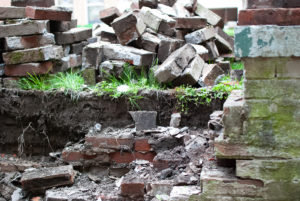
100% of your donation will be used for much-needed repair and restoration work underway this summer at the Shrine. Among the projects the Shrine is working on is a rebuild of the retaining wall around the courtyard, including reconstruction of the drainage system that was causing flooding at one end of the courtyard that was damaging the wall. The courtyard will be a Marian garden that they hope will supply their altar flowers for next year. Also being replaced are the carriage house doors that have been shut fifty years but will allow access for further repair work on the church and attached convent, which the Shrine will use to host retreats. The historic iron fence that provides some security at the front of the church also needs to be replaced.
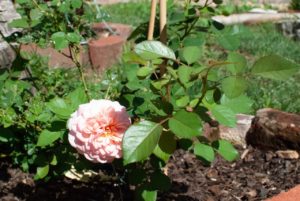
May God reward you for your generosity, both in supplying the spiritual needs of your fallen-away relatives and friends and in supplying the material needs of this beautiful and historic Shrine, which the FSSP has administered for two years now. We are immensely grateful and humbled to care for the Shrine, which counts St. John Neumann and Blessed Francis Xavier Seelos among its former pastors and is a treasure of American Catholicism.
You can see more pictures of the repair work below. Click a picture to learn more, and visit the Shrine’s website to enroll your intentions. +
July 30, 2019

Help Storm-Stricken FSSP Guadalajara!
Fr. Daniel Heenan, FSSP, pastor of Our Lady of the Pillar, our parish in Guadalajara, Mexico, recently sent us a dispatch detailing the vicious storms that have afflicted the area recently. The parish suffered significant damage, and is in need of your help. Read on to find out more.
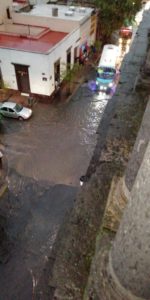
The city of Guadalajara, Jalisco is blessed to enjoy nearly idyllic weather year round. Although heavy rainstorms are not uncommon from June to early October, this year has already seen two that have been particularly tragic. Last week a quick but powerful storm hit the city, the second in a short space of time. Large amounts of hail fell, clogging city streets and drains and causing extensive damage, while intense gusts of wind were powerful enough to knock down trees and break windows.

Older structures such as the church of Our Lady of the Pillar, situated in the historic downtown and home to the FSSP in Guadalajara, were particularly susceptible to the inclement weather. These two storms exacerbated existing problems and caused new damage that will be costly to repair. Estimates are that the church needs around $75,000 worth of structural repairs in total. Right now, however, the parish needs to find close to $15,000 to address the most urgent problems and prevent further structural damage in the short term. The storm broke windows and old stone drainage pipes, causing water to leak into the woodwork. An already outdated and vulnerable electrical system was further at risk. Windows in the skylight in the cupola over the altar broke while Mass was being celebrated. An altar boy had to hold an umbrella over the priest so he could finish Mass without him or the Blessed Sacrament getting wet.
For a parish that it is already on a very tight budget these repairs are going to pose a big challenge and we are grateful for any help that can be offered. To donate, please visit www.fssp.com/missions or give via Paypal.
A Brief History of Our Lady of the Pillar Church
When Guadalajara started to grow towards the southeast of the city, it was necessary to build a new church for the faithful that were living there. Bishop Manuel de Mimbela therefore decided to construct a new church dedicated to Our Lady of the Pillar. The first stone was laid on October 12th, 1718, and the construction was finalized by 1720. The new church was so important that the neighborhood where the church was built was called “Parroquia”, or “parish”, in reference to the church of Pilar. An expansion project was inaugurated on October 6th, 1882, giving the church the current look we see today. The church has a central nave with a side chapel dedicated to St. Nicholas of Bari, a smaller chapel dedicated to the Sacred Heart and a big lateral chapel known as Via Matris (as it has the stations of the Seven Sorrows of Our Lady). The central nave has four side altars dedicated to St. Joseph, Our Lady of Refuge, Our Lady of Guadalupe and lastly to Mary Help of Christians and St. John Bosco.

The church was once the centerpiece of one of the most prestigious areas of downtown Guadalajara. For many years it was a favorite spot for weddings of the upper class. Now it serves as a beacon of hope in the midst of what has deteriorated into the red-light district of the city. This change in the culture of the neighborhood has had significant, negative effects on the finances of the church, making it a much less desirable place to visit.
On August 24th of 1931, during a visit of the pilgrim image of Our Lady of Zapopan, the patroness of the Archdiocese of Guadalajara, a bomb was detonated in an attempt to destroy it. Thanks to her intercession and with the help of several faithful that hid and protected the image, it was saved. Also, the baptistery of the church has the honor to be the place where St. David Galván Bermúdez, martyr of the Cristiada persecution, was baptized. +
July 24, 2019

FSSP Dallas to Host 2nd Blessed Karl Symposium
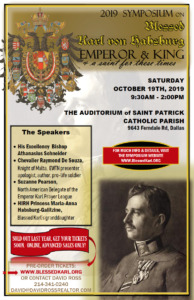 On Saturday, October 19th, 2019, FSSP Dallas will host their 2nd Blessed Karl Symposium. The event follows on the great success of last year’s sold-out inaugural event and will be held at a much larger venue, the parish auditorium of St. Patrick Catholic Church in Dallas. An honored guest last year, Princess Maria-Anna Habsburg-Galitzine, granddaughter of Blessed Karl, will return again this year, and joining for the first time is Bishop Athanasius Schneider, Auxiliary Bishop of Astana, Kazakhstan.
On Saturday, October 19th, 2019, FSSP Dallas will host their 2nd Blessed Karl Symposium. The event follows on the great success of last year’s sold-out inaugural event and will be held at a much larger venue, the parish auditorium of St. Patrick Catholic Church in Dallas. An honored guest last year, Princess Maria-Anna Habsburg-Galitzine, granddaughter of Blessed Karl, will return again this year, and joining for the first time is Bishop Athanasius Schneider, Auxiliary Bishop of Astana, Kazakhstan.
Blessed Karl of Austria was the last emperor of the Austro-Hungarian empire. A voice for peace in the midst of the bloody conflict of World War I, he ascended to the throne in 1916 and was deposed and exiled to the island of Madeira in 1919. He, his wife Servant of God Empress Zita and their family lived there in poverty and he died from illness in 1922 at the age of 35. He was a man of great virtue and a model husband, father and monarch, and he was beatified by Pope St. John Paul II in 2004.
For more information and to buy your tickets, go to the event’s official website, www.blessedkarl.org.
July 20, 2019

Maple Hill Madness
The carefree days of summer are a fun and busy time for our bustling apostolate in Maple Hill, which is situated about 24 miles west of Topeka, KS and is celebrating its 25th anniversary as an FSSP apostolate this year. Fr. Marty Adams, assistant Chaplain at St. John Vianney Chapel, told us more about some of the events that the parish has enjoyed together during the warm weather months.

Each summer, FSSP seminarians are sent out for an assignment, helping at the different Fraternity parishes or organizing and running youth camps, with the goal of gaining valuable knowledge and experience for running a parish someday (God-willing).
There is a wide array of different talents that men bring with them to the seminary, and oftentimes they prove to be very useful at the seminary, in parish life and at the various youth camps happening throughout each summer.
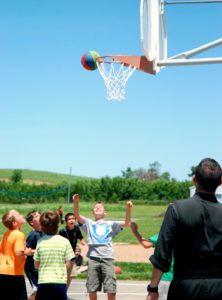
St. John Vianney Chapel in Maple Hill, KS, with the help of one of these seminarians, held a basketball camp on three consecutive Wednesdays – June 19th and 26th and July 3rd – to teach the parish boys some of the fundamentals. Besides playing basketball, the boys get to spend time with the priests and the seminarian, listen to talks on sportsmanship and different virtues important for young Catholic men, participate in communal prayer and compete for best parish team!
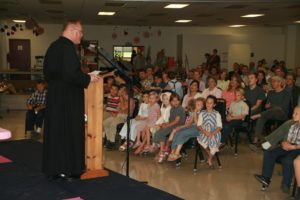
In the midst of that, the families of St. John Vianney hosted their 16th annual family weekend, where anyone looking for a few days of organized, wholesome fun can come together to meet other like-minded Catholics to learn about and grow in their Faith. The event took place during the last weekend in June, in between the last two Wednesdays of the basketball camp.
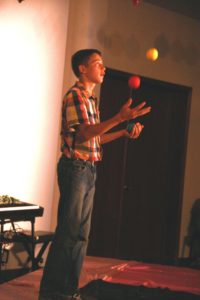
Lectures, organized dancing, sports, a talent show and Holy Mass comprise the event, which has led to happy marriages, the chance for families from different parts of the country to meet and interact, and most importantly, a kindling of the hope that there is still a Catholic culture alive.
This year’s lectures were given by Fr. Scott Allen, FSSP on The Nature & Purpose of Marriage and The Elevation of Marriage by Christ, considered in light of the family of St. Thérèse of Lisieux.
Everyone had a great time, despite the hot Kansas days, and is already looking forward to next year. +
July 18, 2019

Ask Father: July 2019
I’ve never understood this Bible passage from Matthew 11:12: “From the days of John the Baptist until now the kingdom of Heaven has suffered violence, and men of violence take it by force.” – Hugh from Massachusetts
Dear Hugh,
This passage from Matthew reads with a certain harshness to our ears, especially considering the plethora of passages that portray the contrary image of meekness as the model of Christian virtue. “A quiet and a meek spirit which is rich in the sight of God” (1 Peter 3:4; cf. James 1:21; 1 Corinthians 4:21). Moreover, Christ explicitly commands meekness: “Learn of me, because I am meek and humble of heart” (Matthew 11:29), and even enrolls it in the Beatitudes (Matthew 5:4).
But the passivity in the above passages is only one face of Christian warfare. As Josef Pieper says,
There lies a broad field of active worldly endeavor and the struggle for the realization of the good against the opposition of stupidity, laziness, blindness and malevolence. Christ Himself… whose earthly life was entirely permeated and formed by His readiness for sacrificial death, to which He went “like a lamb to the slaughter”—Christ drove the money-changers from the temple with a whip.[1]
The kingdom of heaven is not attained by a weak, unresponsive, victim-oriented psyche, but rather a robust combative vigor is required for certain situations. The warrior image resides behind St. Paul’s lists of military armaments (Romans 13:12; 2 Corinthians 6:7; Ephesians 6:13-17). Albeit, we must always bear in mind that this warfare is primarily spiritual. “For the weapons of our warfare are not carnal but mighty to God, unto the pulling down of fortifications, destroying counsels, and every height that exalts itself against God; bringing into captivity every understanding unto the obedience of Christ” (2 Corinthians 10:3-5). Very often the combat required is against the flesh—“I so fight, not as one beating the air. But I chastise my body and bring it into subjection” (1 Corinthians 9:26-27). Christian life requires tremendous effort against all things which impede discipleship to Christ. It is a violent affair analogous to warfare. Thus, St. Paul’s final farewell to Timothy should be no surprise to us: “I have fought a good fight” (2 Timothy 4:7).
Though the word violence strikes us with force, its proper understanding is in the above citations. Not as something opposed to meekness, but as something that is required by the virtue of meekness. One must not let fear or despair forestall grace and sanctification. Some situations require forbearance, yet not all…“if thy hand, or thy foot, scandalize thee, cut it off, and cast it from thee” (a violent image indeed!). “It is better for thee to go into life maimed or lame, than having two hands or two feet, to be cast into everlasting fire” (Matthew 18:8).[2]
The key to the passage resides in the timeframe Christ places as an introduction, i.e., “From the days of John the Baptist until now.” Turn to the Baptist to understand the spiritual sense of “men of violence.” The Baptist was himself a dynamo, explosive and bursting in energy. According to Jerome, the symbol of Mark’s Gospel is a lion precisely because it commences with the voice of the
Baptist “roaring” in the wilderness: “Prepare ye the way of the Lord” (Mark 1:3).[3] The life of the Baptist was an example of what he preached. The Baptist lived a life of penance and proclaimed in earnest the necessity for his fellow men to repent, not only in words, “confessing their sins,” but also in deeds—“You brood of vipers!…bring forth fruit worthy of penance” (Matthew 3:8).
That voice which echoed in the hostile desert did not fall on deaf ears. Many repented in earnest, some eventually became apostles (Andrew and possibly John, cf. John 1:37-40). From the commencement of the Baptist’s preaching, Heaven was being stormed by those who heeded his message and as St. Jerome says, “There is great violence involved when we who have been born on the earth seek to possess a heavenly home through virtue.”[4]
The voice of the Baptist reverberates through the centuries and continues to teach. It moved St. Antony (†356) to flee into the desert. And upon hearing of St. Antony’s story a young Augustine (†430) seized his friend and cried out, “What is wrong with us? What is this? What heardest thou? The unlearned start up and ‘take’ heaven, and we, with our learning, but wanting heart, see where we wallow in flesh and blood!” Moments later Augustine converted and—after seizing Christ—would clutch the gates of heaven, even to his last breath.
Though a body nourished on locusts and honey was certainly emaciated, the Baptist remained unbent and his life was constantly colored with uncompromising confrontation, from pharisees to kings. Ironically, the Baptist who encouraged others to war, not against other men but against their own sins, suffered violence of the earthly sort at the end. Indomitable, even in prison and under the headsman’s axe, he violently grasped up toward Heaven and pointed others in the same direction (Matthew 11:2ff.). His head was laid low, yet no man greater has been born of woman (cf. Matthew 11:11). We would do well to heed his call, for the kingdom of heaven is at hand—and it only yields to the violent. +
Regnum coelorum suffers violence gladly
from fervent love, from vibrant hope—
only these powers can defeat God’s will:
not in the way one man conquers another,
for That will [God’s] wills its own defeat, and so
defeated it defeats through its own mercy.
Dante Alighieri, Paradiso, Canto XX, 94-99
Answered by:
Fr. Dominic Savoie, Assistant Pastor, FSSP Sacramento
- Josef Pieper, The Four Cardinal Virtues, 131-132.
- As a side note, there is no historical evidence of maimed one-eyed Christians processing
through the centuries—save one suspected incident (Origen). This should serve as a
warning against gross literal interpretation of Scripture and the necessity of reading it
through tradition. - According to Jerome, see Homily 75.1 and Commentary on Matthew, preface.
- Jerome, Commentary on Matthew, ed. Thomas P. Halton, trans. Thomas P. Scheck,
vol. 117, The Fathers of the Church (Washington, DC: The Catholic University of
America Press, 2008), 131–132.
July 15, 2019

Corpus Christi 2019
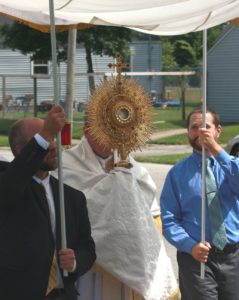
On Thursday, June 20th and Sunday, June 23rd, 2019, parishes throughout the world celebrated Corpus Christi, the great feast of the Most Blessed Sacrament. The feast falls on the Thursday after Trinity Sunday, but is often commemorated as an External Solemnity on the following Sunday. One of the central features of the liturgy of this day is a beautiful procession after Mass with the Blessed Sacrament enthroned in the monstrance, the route traditionally including several altars set up along the way at which the procession halts and the Blessed Sacrament is adored. And so today we bring you, over 5 states, 5 countries and 5 time zones, the celebrations of the Sacrament that unites and transcends all three. +
Hic est panis, qui de cœlo descéndit. Non sicut manducavérunt patres vestri manna, et mórtui sunt. Qui mandúcat hunc panem, vivet in ætérnum.
This is the bread that has come down from heaven; not as your fathers ate the manna, and died. He who eats this bread shall live forever.
– John 6:58 (from the Gospel for the feast of Corpus Christi)
FSSP Dallas
Mater Dei Parish
FSSP Dayton
Holy Family Parish
Some parishes create elaborate carpets of dyed wood chips or flowers for the Corpus Christi procession. Dayton’s are real masterpieces.
FSSP Harrisburg
Mater Dei Latin Mass Community at St. Lawrence Chapel
FSSP Houston
Regina Caeli Parish
FSSP Guadalajara
Templo Nuestra Señora del Pilar
FSSP Lyon
Collégiale Saint-Just, Lyon, France
FSSP Providence
St. Mary’s Church on Broadway
FSSP South Bend
St. Stanislaus Parish
FSSP Vancouver
Holy Family Parish
Photos by Crystal Matthews, Christine Uy, Claire Phillips
FSSP Warrington
St. Mary’s Shrine, Warrington, UK




